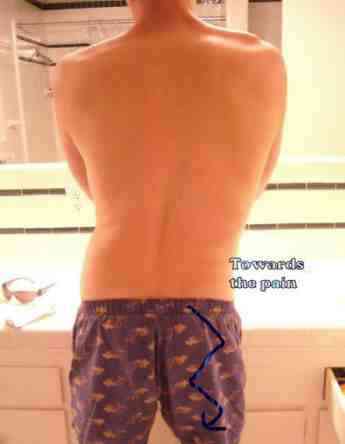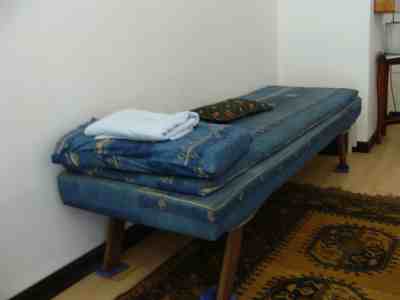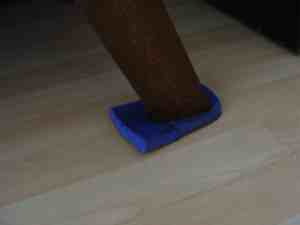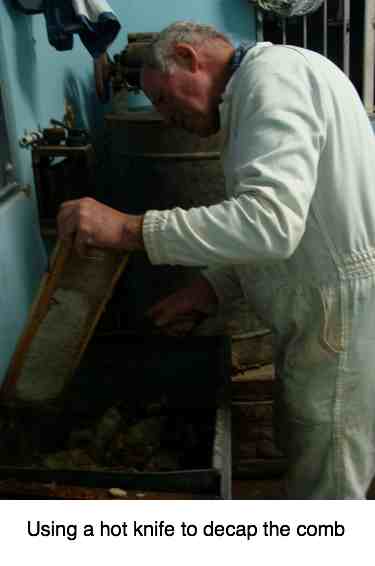Dear
Popping your own neck
Ask any chiropractor, and s/he will tell you that the most difficult
patient in the practice is the one who begins to manipulate their own
joints. It leads inexorably to pain and tingling in arms and hands, and
degenerative arthritis in tiny joints known as the Joints of Luschka, also known as the ... go to our self manipulation page for the solution.
The postero-medial slipped disc
I have a love-hate relationship with the postero medial disk herniation ...
I love
treating the patient with the medial disc injury. They respond much more quickly than the patient with the lateral disc. Patients think I have golden hands. But there's a but... and it's a big BUT. Both the medial and the lateral disc herniation take six weeks to heal with chiropractic care, assuming you go quickly to your chiropractor when you KNOW you've done yourself a mischief. Reduce the bulging disc before the inflammation and swelling set in.
That BUT. Because the pain is gone, or nearly gone in a week, you stop the treatment, forget about the lower back exercises and go back to tennis, golf, gardening... before that disc has healed, and bang, you re-injure the joint.
Research shows that far more medial disc injuries end up in surgery than lateral discs. But they really are much less problematic. If you go through with the Chiropractic Help, do the rehab, and wait out the
six weeks. If...
How do you know if you have a medial disc injury?
The Flip Test.
Sit in a normal chair and slowly straighten first one leg parallel to the ground. Lower it, and now straighten the other knee.
If the low back pain is increased more by raising the opposite leg, then you may have a medial disc injury.
Say for example you turned the mattress on your bed and developed sharp stabs of pain in the right lower back. If, whilst doing the Flip Test, raising the left leg hurts more than the right, you may have a medial disc bulge. For more details: Slump Test for sciatica ...
For Chiropractors...
Some chiropractors are very slow to figure things out. I'm one of
them.
For twenty-five years I've used my faithful pelvic bench for adjusting the lower back and pelvis. Then I went to Holland for seven years, but when I returned to semi retirement in this my new clinic, I couldn't get releases, or not nearly as easily. But why...? The same bench, the same joints, the same hands...
Eventually the penny dropped, after more than two whole years, I confess. In my previous clinic, old faithful stood on a sprung wooden floor. Here, under that wood laminate is solid concrete. It doesn't give at all.
The solution? A derelect pair of slip slops from which the thongs had perished.
I really
should have worked this out sooner as I knew that it's the principle that the great innovative chiropractor Clay Thompson used to develop the modern chiropractic adjusting table. Read more at Sacroiliac joint treatment ...
RAW HONEY
Honey, like omega-3 fatty acids, is an extremely sensitive product. The omega-3 doesn't like oxygen. Honey doesn't like heat, light and microwaves. And virtually all the honey you buy in shops has been heated. Frankly, I think it has little more value than sugar, and all of the disadvantages. Honey has a very high Glycemic Index.
What's special about raw honey? An enzyme called Glucose Oxidase, added by bees to the raw nectar, is vital in the production of Hydrogen Peroxide (H2O2), the agent that gives honey its antibacterial activity. And glucose oxidase is particularly heat labile.
It's the
presence of Glucose Oxidase that makes honey a special ingredient in the treatment of varicose ulcers and burns for example. Varicose veins and herbs ...
It's also the reason, more controversially, why raw honey is used by some paediatricians in the treatment of diarrhoea in infants. Controversially because there are eight reported cases of infants who contracted botulism, thought to be after eating raw honey. But these toddlers were all probably exposed to common dirt, earth where the bacteria is found. What's more there are about 100 cases of infant botulism in the USA EACH YEAR, probably none of which were exposed to raw honey. There are very few families that have ever had the joy (and danger?) of being exposed to raw honey.
Ours is one of them...
Raw honey is a very special food in my opinion. The taste is divine, the micronutrients invaluable, and the (heat- and light-labile) enzymes very beneficial in digestion.
Raw honey, only available from your local small beekeeper, also is usually only lightly filtered, allowing small particles of pollen and the wax cappings into the honey. These are beneficial for people suffering from asthma, hayfever and sinusitis.
But all honey, raw or commercial, must be eaten in conjunction with fat, fibre and preferably protein too. For example, in an oats porridge or muesli, or on a cheese and honey buttered whole wheat sandwich. Why...?
BATS IN MY BELFRY
It's taken an age, but at last my second book of Chiropractic anecdotes is available as an ebook for only $2.99 on your Kindle, Nook, tablet or smartphone. Love to read? See what others have said:
- I have been enjoying Bats
in my Belfry thoroughly, almost finished it! Well written. Mike Buchholz, Johannesburg.
- I
thoroughly enjoyed your lecture last November and bought a copy of your
book "Bats in my Belfry". I really enjoyed it and so did my wife - who
thanks to you now has a much better idea of what clinical life is
about. Mark Walles, Bournemouth.
- Good
luck with the book promotions - I think that Bats in my Belfry is a
great book ! Students should take sometime out to give it a read as
there are some valuable lessons that they could learn. Dr Charmaine
Korporaal, Durban University of Technology (Chiropractic).
- How I enjoyed your book, I could hardly put it down. Kathleen Mack, Valley of the Thousand Hills, South Africa.
-
Thank you for all the pearls of wisdom - I really enjoyed the Frog in
my Throat book, as well as the excerpts from Bats in my Belfry. Dr Neil Stakes, Singapore.
- Your
writing is delightful. Anne Taylor-Vaisey, Toronto
- You are a talented writer. Good reading. Dr Warren Hammer, Connecticut.
-
I enjoyed Bats in my Belfry and was drawn to keep reading chapter after
chapter. I gave my copy of the book to my chiropractor and he commented
that he now had some insight into another chiropractor’s perspective.
Some of the book was heavy, the silent weekend. Some of it was
suspenseful, the gliding journey. Some of it was sad/frustrating, Sipho.
I started to wonder when I read the car incident story about how it
can't be possible that all these events could happen to one person in a
lifetime. Maybe I just haven't "lived" enough yet! Clearly Dr Preston
has had many interesting stories to tell in the book, but I think that
putting them all together and drawing the thread between them was the
challenge he faced. Is a book a success if the author grows as a person
while writing it? Or is it a
success only if many other people can
find the book and enjoy reading it? Kevin L, Chicago.
"As the twig is bent, the tree's inclined."
Alexander Pope
Aside: Pope, one of the world's greatest poets suffered terribly in life from pain. Dr Mardy tell us that "Pope suffered from a childhood illness that caused a curvature of the spine which limited his adult growth to four feet, six inches. He also
suffered from many other ailments, including rickets, severe migraines, asthma, and tuberculosis (in one of his poems, he wrote tellingly of his condition: "This long disease, my life"). Even though he was in constant pain, he had an indomitable spirit and accepted his physical condition in good humour.
Do you get Dr Mardy's free weekly email? I love it. DrMardy.com
Till next month, then...
Barrie Lewis DC
PS. Feel free to forward this to family and friends, your chiropractor and even your medical doctor!
CHIROPRACTIC HELP Backissues of our newsletters.





